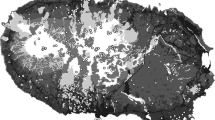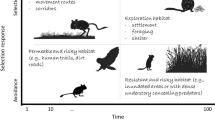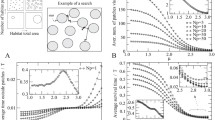Abstract
The increasing use of the landscape by humans has led to important diminutions of natural surfaces. The remaining patches of wild habitat are small and isolated from each other among a matrix of inhospitable land-uses. This habitat fragmentation, by disabling population movements and stopping their spread to new habitats, is a major threat to the survival of numerous plant and animal species. We developed a general model, adaptable for specific species, capable of identifying suitable habitat patches within fragmented landscapes and investigating the capacity of populations to move between these patches. This approach combines GIS analysis of a landscape, with spatial dynamic modeling. Suitable habitat is identified using a threshold area to perimeter ratio. Potential movement pathways of species between habitat patches are modeled using a cellular automaton. Habitat connectivity is estimated by overlaying habitat patches with movement pathways. The maximum potential population is calculated within and between connected habitat patches and potential risk of inbreeding within meta-populations is considered. The model was tested on a sample map and applied to scenario maps of predicted land-use change in the Peoria Tri-county region (IL). It (1) showed area of natural area alone was insufficient to estimate the consequences on animal populations; (2) underscored the necessity to use approaches investigating the effect of land-use change spatially through the landscape and the importance of considering species-specific life history characteristics; and (3) highlighted the model's potential utility as an indicator of species likelihood to be affected negatively by land-use scenarios and therefore requiring detailed investigation.
Similar content being viewed by others
References
Andreassen, H. P., Halle, S. and Ims, R. A.: 1996, ‘Optimal width of movement corridors for root voles: Not too narrow and not too wide’, J. Appl. Ecol. 33, 63–70.
Chamberlain, M. J., Leopold, B. D. and Conner, L. M.: 2003, ‘Space use, movements and habitat selection of adults bobcats (Lynx rufus) in Central Mississippi’, Am. Midl. Nat. 149, 395–405.
Deal, B.: 2001, ‘Ecological urban dynamics: The convergence of spatial modelling and sustainability’, Build. Res. Inform. 29, 381–393.
Deal, B., Farello, C. A., Lancaster, M., Kompare, T. and Hannon, B.: 2000, ‘A dynamic model of the spatial spread of an infectious disease: The case of fox rabies in Illinois’, Environ. Model. Assess. 5, 47–62.
Gehring, T. M. and Swihart, R. K.: 2003, ‘Body size, niche breadth, and ecologically scaled responses to habitat fragmentation: Mammalian predator in agricultural landscape’, Biol. Conserv. 109, 283–295.
Gibb, H. and Hochul, D. F.: 2002, ‘Habitat fragmentation in an urban environment: Large and small fragments support different arthropod assemblages’, Biol. Conserv. 106, 91–100.
Helzer, C. and Jelinski, D. E.: 1999, ‘The relative importance of patch area and perimeter-area ratio to grassland breefing birds’, Ecol. Appl. 9, 1448–1458.
Mac Nally, R., Bennett, A. F. and Horrocks, G.: 2000, ‘Forecasting the impacts of habitat fragmentation on birds in the box-ironbark forests of central Victoria, Australia’, Biol. Conserv. 95, 7–29.
Maxwell, T., Villa, F. and Costanza, R.: 2002, ‘The Spatial Modeling Environment’, International Institute for Ecological Economics, Center for Environmental Science, University of Maryland System, Solomons, MD. Available at http://www.uvm.edu/giee/SME3.
Parker, M. and Mac Nally, R.: 2002, ‘Habitat loss and the fragmentation threshold: An experimental evaluation of impacts on richness and total abundances using grassland invertebrates’, Biol. Conserv. 102, 217–229.
Rafferty, J. P., Aurambout, J. P. and Deal, B.: in review, ‘Modeling the population response of the raccoon (Procyon lotor) to land use change in North Aurora, Illinois’, Ecol. Model.
Schmiegelow, F. K. and Mönkkönen, M.: 2002, ‘Habitat loss and fragmentation dynamic landscapes: Avian perspectives from the boreal forest’, Ecol. Appl. 12, 375–389.
Schmitt, T. and Seitz, A.: 2002, ‘Influence of habitat fragmentation on the genetic structure of Polyommatus coridon (Lepidoptera: Lycaenidae): Implications for conservation’, Biol. Conserv. 77, 291–297.
Schumaker, N. H.: 1996, ‘Using landscape indices to predict habitat connectivity’, Ecology 77, 1210–1225.
Sih, A., Jonsson, B. G. and Luikart, G.: 2000, ‘Do edge effects occur over large spatial scale?’ Tree 134–135.
Simberloff, D. and Cox, J.: 1987, ‘Consequences and costs of conservation corridors’, Conserv. Biol. 1, 63–71.
Templeton, A. R., Shaw, K., Routman, E. and Davies, S. K.: 1990, ‘Genetic consequences of habitat fragmentation’, Ann. Miss. Bot. Gard. 77, 13–27.
Tigas, L. A., Van Vuren, D. H. and Sauvajot, R. M.: 2002, ‘Behavioral responses of bobcats and coyotes to habitat fragmentation and corridors in an urban environment’, Biol. Conserv. 108, 299–306.
Tscharntke, T.: 1992, ‘Fragmentation of Phragmites habitats, minimum viable population size, habitat suitability and local exctinction of moths, midges, flies, aphids and birds’, Conserv. Biol. 6, 530–536.
Wilcox, B. A. and Murphy, D. D.: 1985, ‘Conservation strategy: The effect of fragmentation on extinction’, Am. Nat. 125, 879–887.
Author information
Authors and Affiliations
Corresponding author
Rights and permissions
About this article
Cite this article
Aurambout, J.P., Endress, A.G. & Deal, B.M. A Spatial Model to Estimate Habitat Fragmentation and Its Consequences on Long-Term Persistence of Animal Populations. Environ Monit Assess 109, 199–225 (2005). https://doi.org/10.1007/s10661-005-6266-1
Received:
Accepted:
Issue Date:
DOI: https://doi.org/10.1007/s10661-005-6266-1




